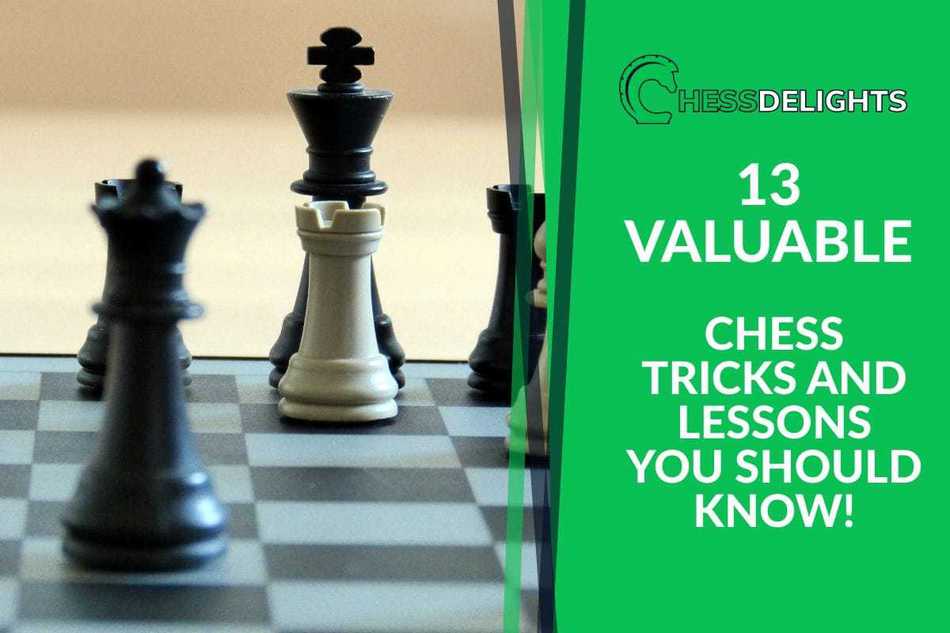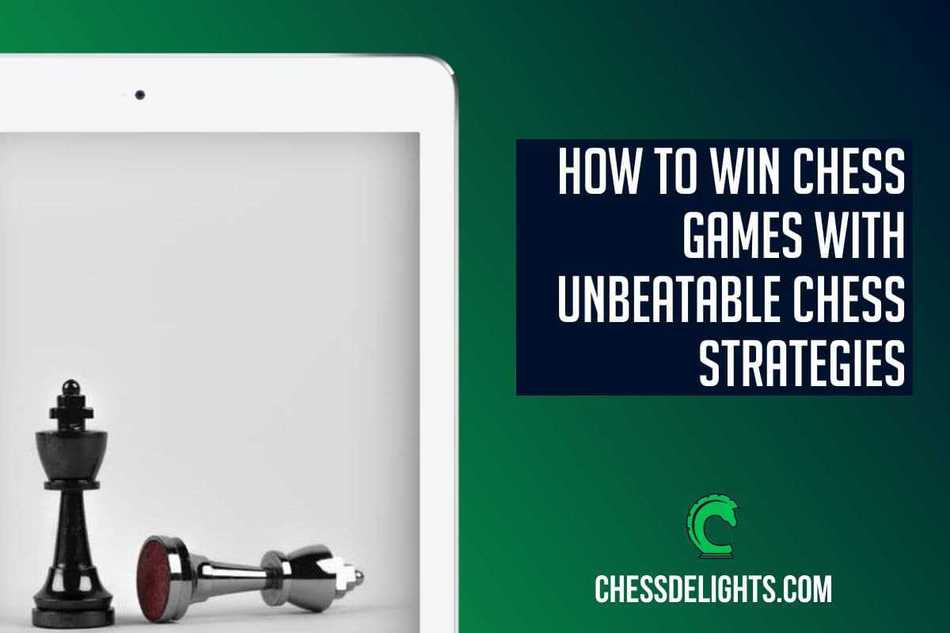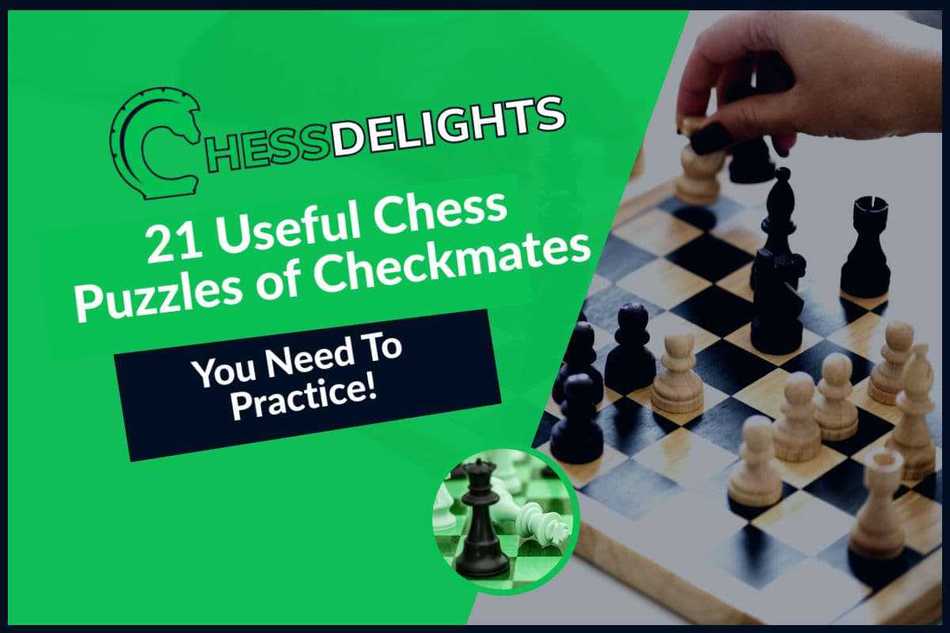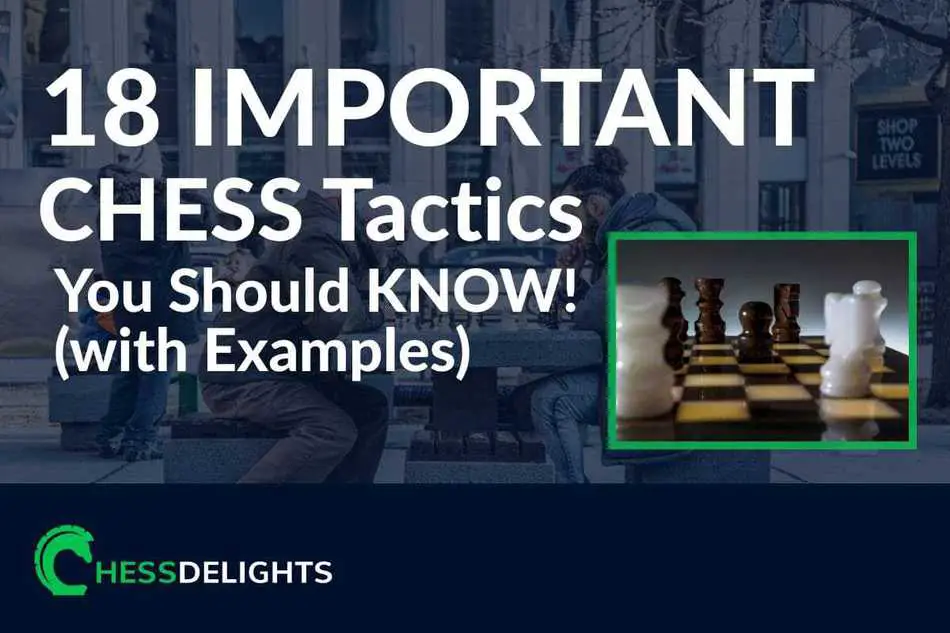Have you ever wanted to learn so many chess tricks? Maybe even asking yourself what chess tricks or lessons I need to learn. Well, I ask that same questions myself…
And to be honest, you need to be practicing a lot and playing chess regularly to become competent in implementing and at the same time avoiding chess tricks or traps your opponent can use against you.
There are a lot of chess lessons that you can study and learn, even chess tricks or traps that are fun to watch.
But I chose to select essential and common chess lessons, tricks, and traps that can happen within the three part of the chess games.
Table of Contents
Chess Lessons, Tricks and Traps in the Opening Games
Don't be too confident when playing with a kid or a younger chess player. You might see yourself losing after only a few moves.
When you are playing in the opening games of chess, you need to be aware of chess tricks or traps. You may have encountered or known a lot of chess tricks or traps from Grandmasters, but some chess opening tricks are very common and can even still trick some excellent chess players.
Recommended Reading: If you want to learn more about chess strategies, read this article.
1. Capturing Pawns(Gambit) Can Lead To A Double Attack(Black Wins)
Most of the time, I ignore the need to understand the situations in an opening game…
Especially if it is only 3 to 4 moves early in the game. This is a huge mistake because we can easily miss a Double Attack that your opponent is planning.
A trick wherein your opponent gives up its pawn in the third move.
See chess image below…
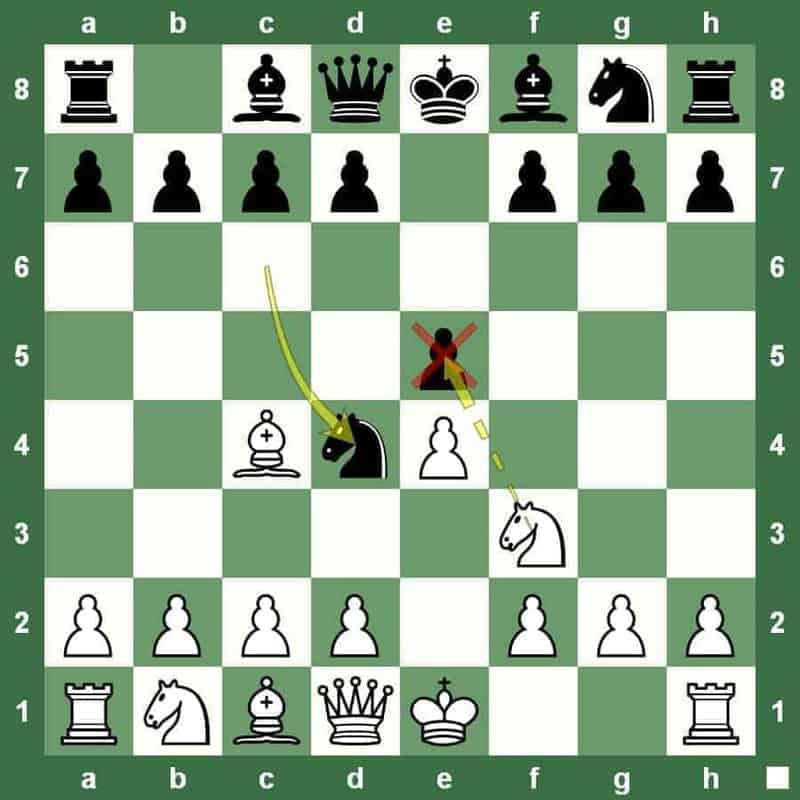
When the White Knight Captures the Pawn, that is where the trap starts to unfold. The next move is the Queen, creating a Double Attack to the Knight and the Pawn in “g2”.
This trick and example for chess opening lead to a checkmate, not just an ordinary checkmate but a Smothered Checkmate.
The lesson you need to remember is if it is early in the game and there is an apparent capture, looks free and moves the same piece twice – you need to think hard and look for some traps or in this case Double Attack.
Check out the chess opening game trap and notation below:
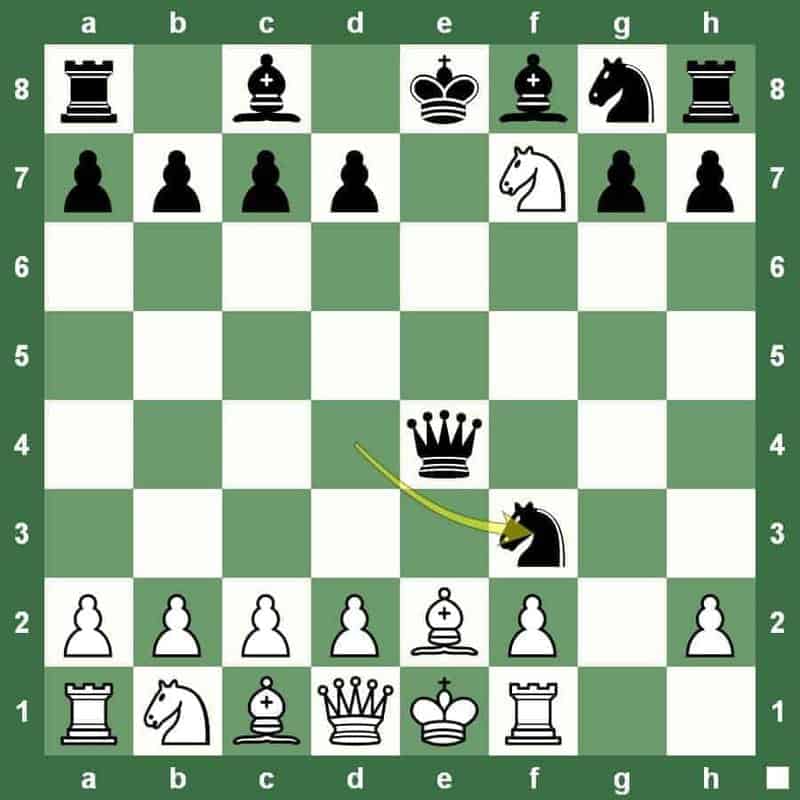
1. e4 e5 2. ♘f3 ♘c6 3. ♗c4 ♘d4 4. ♘xe5 ♕g5 5. ♘xf7 ♕xg2 6. ♖f1 ♕xe4+ 7. ♗e2 ♘f3#
2. Ignored Pawn Attack Becomes A Queen (Black Wins)
Although this could also be a pawn capture trap, it is not… The idea in this chess trick is to lure the Knight to the g3. That is where it should start, and that is where the pawn becomes a Queen. See chess image below…

So, this chess trick will have to capture the Knight and then the Rook will be attacking the h file, and eventually trading with White's Rook.
When this happens, White will be in a lot of trouble, even with the Bishop is ready to capture the pawn. This is where the Queen will make its check move and then sacrificing by capturing the White Bishop.
Most of us will ignore the Pawn making a move on the h file, and it will be a little bit too late till we find out that we are in a lot of trouble because of that simple move. The lesson here is do not ignore any move by pawn, especially even if you think it is a little bit silly, and it is not. 🙂
Check out the chess opening game lesson and notation below:

1. e4 c6 2. d4 d5 3. ♘c3 dxe4 4. ♘xe4 ♘f6 5. ♘g3 h5 6. ♗g5 h4 7. ♗xf6 hxg3 8. ♗e5 ♖xh2 9. ♖xh2 ♕a5+ 10. c3 ♕xe5+ 11. dxe5 gxh2
3. Too Many Chess Piece Sacrifices Can Lead To Checkmate (White Wins)
You know that you are winning the exchanges and you might even think that your opponent does not know how to play chess…
If you do notice your opponent is giving up chess pieces easily, you need to be thinking something is not right here. The good thing about knowing this chess piece sacrifices in this example is that you know you are winning the exchanges. 🙂
White pawns are sacrificed early on the game, and then slowly the White develops key minor chess pieces. When you are on the receiving end of this chess trick you need to be very careful, especially if you can only see your opponent's chess pieces are on the board.
See chess image below.
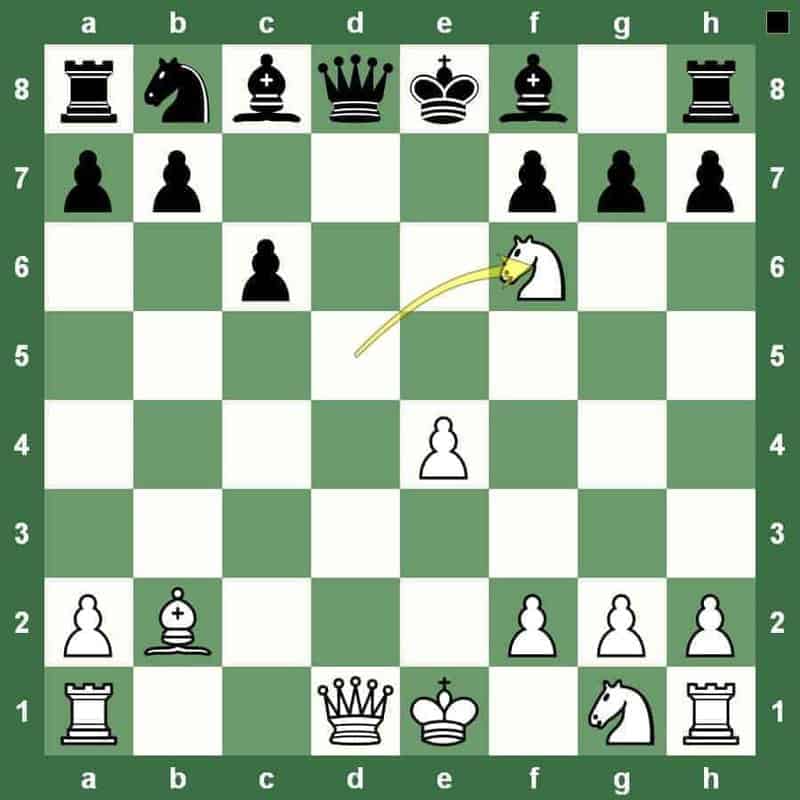
So, after all the sacrifices, the King is being lured outside of its comfort zone. Once you can expose the King, that is where all the pawn sacrifices are all worth it.
This chess trick made it easy for White to create a plan of attack where your opponent cannot do anything to protect the Black King. The lesson here is to develop your chess pieces as well and put your King to safety as soon as possible.
Check out the chess opening game trick and notation below:

1. e4 e5 2. d4 exd4 3. c3 dxc3 4. ♗c4 cxb2 5. ♗xb2 d5 6. ♗xd5 ♘f6 7. ♘c3 ♘xd5 8. ♘xd5 c6 9. ♘f6+ ♔e7 10. ♗a3+ ♔e6 11. ♕g4+ ♔xf6 12. e5+ ♔xe5 13. ♘f3+ ♔f6 14. ♕g5+ ♔e6 15. ♕e5+ ♔d7 16. O-O-O+ ♗d6 17. ♕xd6+ ♔e8 18. ♕xd8#
4. Do not ignore Obvious Queen Attacks(White Wins)
For me, the very worse thing that can happen in a game is having your Queen Trapped early on the game… I have fallen for so many Queen traps, and losing your Queen can make you upset.
For chess experts, this type of chess tactic may not work, but for a novice, this can be easily overlooked. The White Bishop attacks the Black Queen, and Black moves the pawn, which seems to be the right move.
See chess image below…
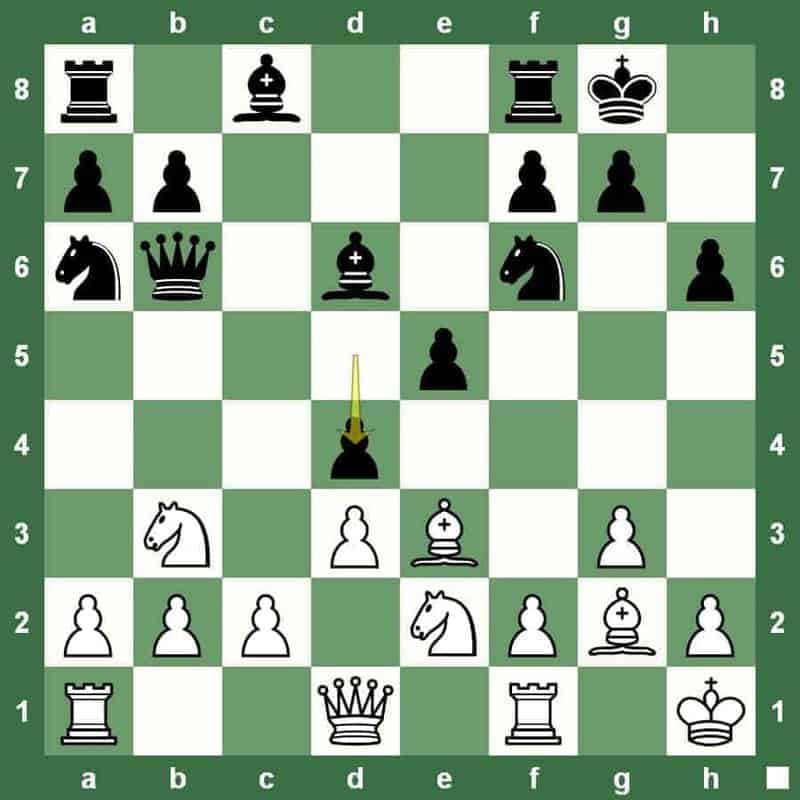
Now after the pawn moves the Bishop retreats but has an apparent attack to the Black Queen, when there is an apparent attack with the Queen, check immediately if there are available squares to move the Queen safely.
But the planned attack was ignored, instead made a blunder move by moving the Black Bishop, Black paid the price and eventually will lose the Black Queen.
The lesson here is do not ignore an apparent attack to your Queen, and check safe squares for your pieces to escape. To avoid chess traps like this.
Check out the chess opening game trap and notation below:
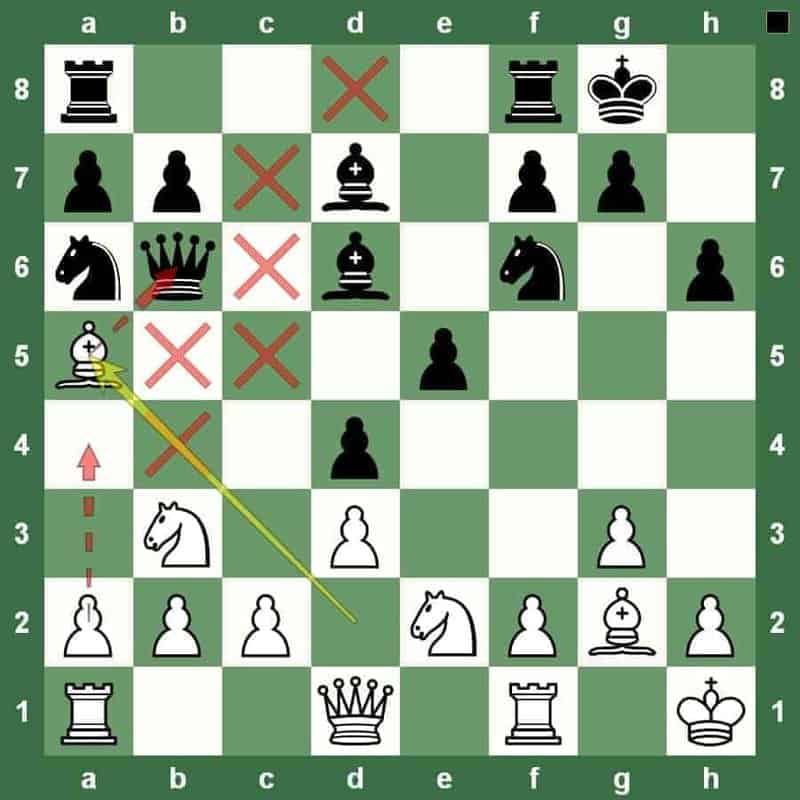
1. d3 d5 2. g3 ♘f6 3. ♗g2 c6 4. ♘d2 e5 5. e4 ♗d6 6. ♘e2 O-O 7. O-O ♘a6 8. ♔h1 ♕b6 9. exd5 cxd5 10. ♘b3 h6 11. ♗e3 d4 12. ♗d2 ♗d7 13. ♗a5 ♕b5 14. a4
Chess Lessons, Tricks and Traps in the Middle Games
This is the part of the game where you have successfully passed the opening games… It is at this time that we need to keep our focus and committing mistakes in this part of the game can be very critical and will be very difficult to correct those mistakes.
In the Chess Middle Games, you need to start taking calculated risks, you cannot miss any opportunities, and you have to take the chance to commit to certain moves that you know will win the game.
Here are some Chess Middle Games lessons, tricks, and traps you should know.
5. Put Your King To Safety First Before Attacking (White Wins)
It can be tempting to start the attack after calculating the moves in your head, and you decided that you can start an attack or a sacrifice…
But only if you are 100% sure that your King should be already in a safe square without any “in-between” moves your opponent can try to use on you.
A miscalculated move like in our example lead a resignation because the Black was expecting a different answer from White after Black captured the d4 pawn.
See chess image below:
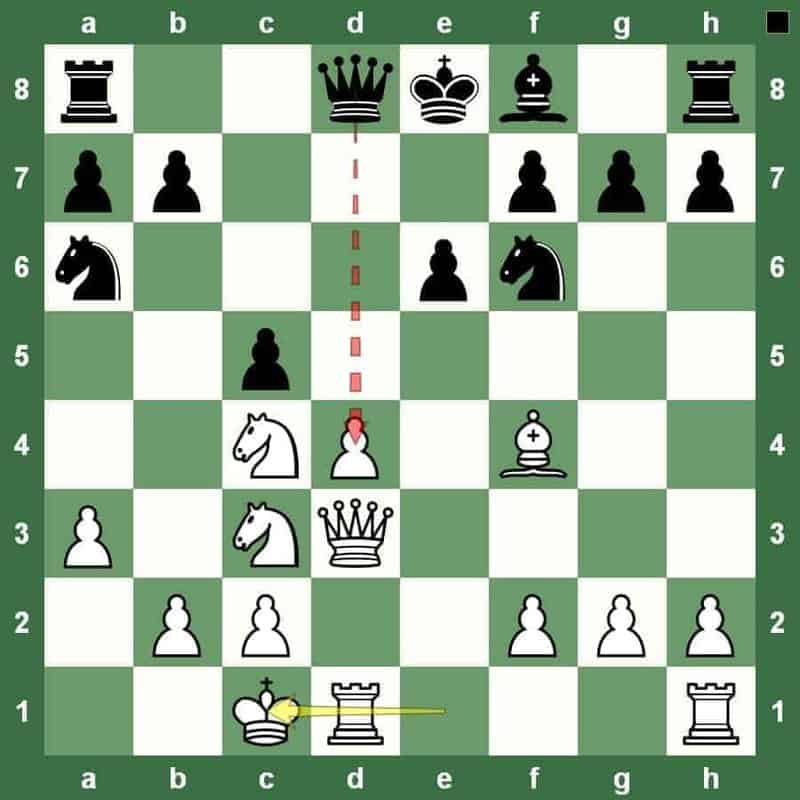
If Black realized that a check from a Knight could trap the Black Queen, and capturing the Knight with a Bishop will still check the Black King and a Discovered Attack by the Rook to win the Queen is inevitable.
Then Black could have made a better plan of putting the King in a safe square first before initiating the capture of the pawn in d4.
The lesson here is to keep your King to safety first and do not become too eager to attack if you have not done the right calculations of move in your head yet.
Check out the chess middle game trap and notation below:

1. e4 d5 2. exd5 ♕xd5 3. ♘c3 ♕a5 4. ♘f3 ♘f6 5. d4 c6 6. ♘e5 ♗f5 7. ♘c4 ♕d8 8. ♗f4 e6 9. ♗d3 ♗xd3 10. ♕xd3 ♘a6 11. a3 c5 12. O-O-O ♕xd4 13. ♘d6+
6. Take Advantage and Force Opponent To Lose A Tempo (White Wins)
We know that we can't always make the right moves in chess, and if you are not careful, you will end up losing the game.
Typically, we expect our opponent to make certain moves that we do think is the best reply to your attack or chess move…
And if your opponent does not make the move that we expect, then we need to take advantage of that right away.
Just like in this example for the middle game, the White Knight captured the Black Knight and at the same time attacked the Black Queen.
See chess image below:
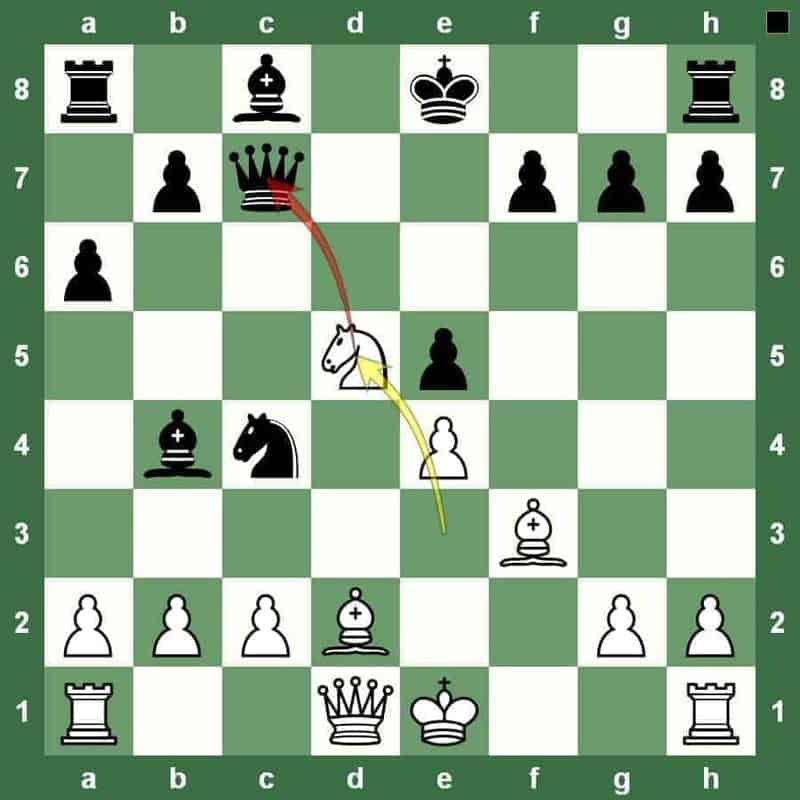
Now, White is expecting the Black Queen to move on c5 which could be the best move, but instead the Black Queen move on c6.
The Black Queen is no longer guarding the e5 pawn and the center square. White saw the chance to take advantage of that and expecting Black to lose a tempo because of White Queen threat on e7 and at the same time double attack on g7 and e5 pawn.
This is an excellent example of taking advantage and anticipating your opponent to lose a tempo if your opponent did not make the right move which you were expecting. The lesson here is to identify your opponent's possible moves and prepare a counter play that will give you an advantage and win the game.
Check out the chess middle game tactic and notation below:
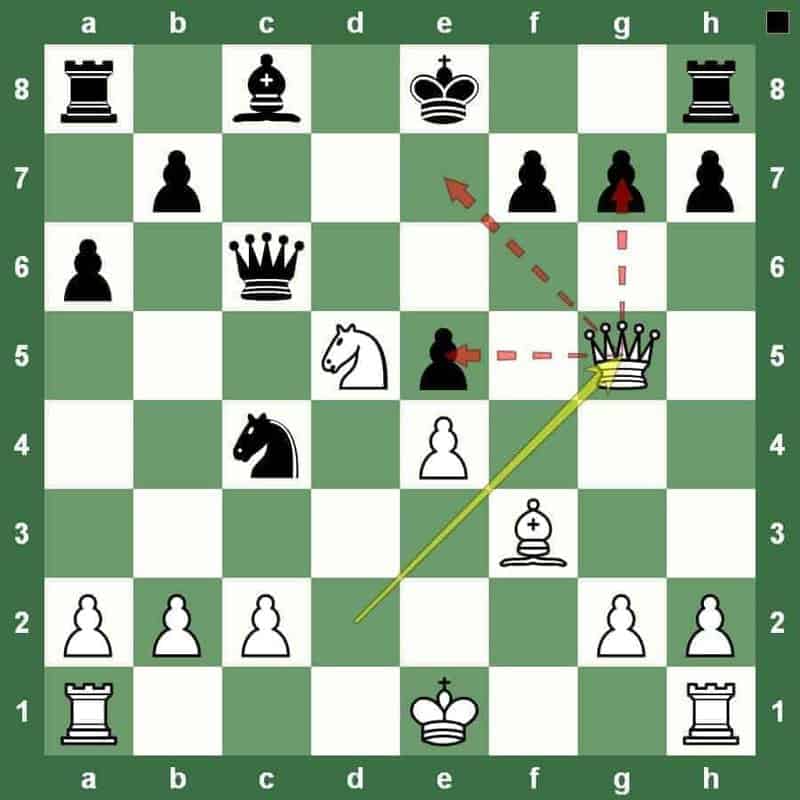
1. e4 c5 2. ♘f3 d6 3. d4 cxd4 4. ♘xd4 ♘f6 5. ♘c3 a6 6. f4 ♘bd7 7. ♗e2 e5 8. fxe5 dxe5 9. ♘f5 ♕c7 10. ♗f3 ♘b6 11. ♘e3 ♗b4 12. ♗d2 ♘c4 13. ♘cd5 ♘xd5 14. ♘xd5 ♗xd2+ 15. ♕xd2 ♕c6 16. ♕g5 ♕c5 17. ♕xg7 ♖f8
7. Keep Looking For Strong Positions (Black Wins)
As a novice chess player, we try to learn more about opening games and then learn the variations…
But once you enter the middle game, you need to learn how to keep looking for strong positions in your game. When you have better positioning, we get excited and lose focus and don't know what your plan of attack would be.
If your opponent has a better understanding of the middle game, they will keep on looking for stronger positions for their chess pieces and try to gain material advantages as much as they can.
In our example below, the Black keeps on looking for stronger positions that it can leave its Queen hanging and ready to be captured by White. See chess image below:
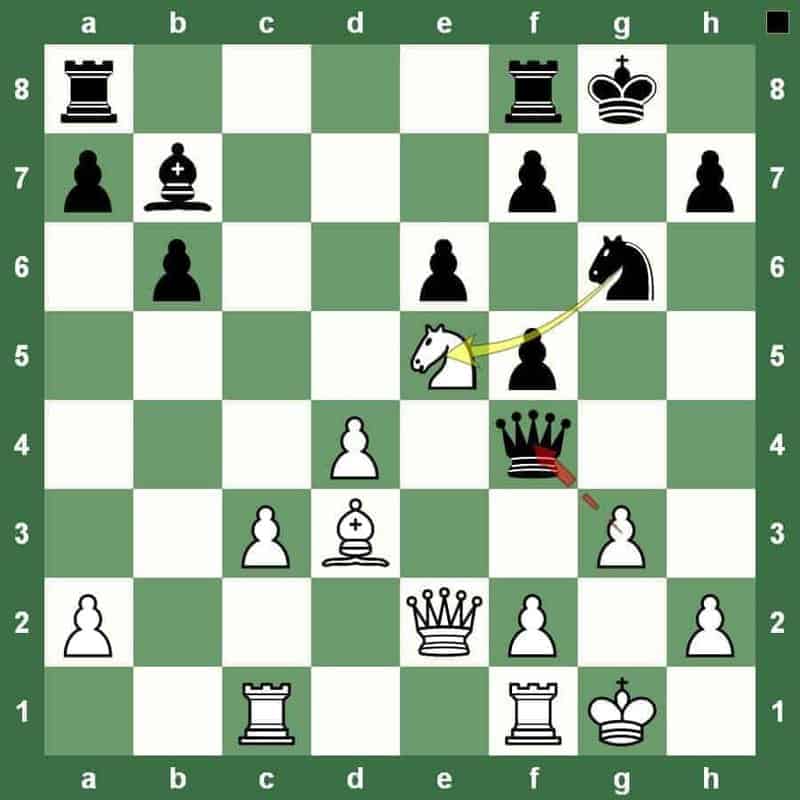
Black was able to find a plan to gain material advantage from white and used the pin to capture White's pawn.
This will solidify Black's plan on promoting its pawn and taking advantage of the Pin with White Bishop and Rook.
The lesson here is to defend and at the same time look for a better position for your chess pieces, and avoid getting into pins.
Check out the chess middle game tactic and notation below:

1… ♘xe5 2. gxf4 ♘f3+ 3. ♕xf3 ♗xf3 4. ♖fe1 ♖fd8 5. ♖e3 ♗b7 6. ♖g3+ ♔f8 7. ♖d1 ♖ac8 8. ♗c2 ♔e7 9. ♗b3 ♔f6 10. c4 ♗a6 11. ♖c3 ♖g8+ 12. ♔f1 ♖g4 13. f3 ♖xf4 14. ♔f2 ♖h4 15. ♔g3 ♖h5 16. ♖c2 ♗b7 17. d5 exd5 18. cxd5 ♖xc2 19. ♗xc2 ♗xd5 20. ♖d2 ♗e6 21. ♗b3 ♖g5+ 22. ♔f4 ♖g1 23. ♖f2 ♖b1 24. ♗c2 ♖b2 25. ♖e2 ♖xa2
8. Block Your Opponent's Important Squares When You Have A Material Advantage (Black Wins)
It would be wise to start trapping chess pieces in the middle game… When you have an advantage of chess pieces, you should also be looking at how you can capture or stop your opponent from advancing its chess pieces like their pawns.
If you don't have a concrete plan of attack to your opponent's King, then you should try putting more pressure on their chess pieces and try to make necessary exchanges to simplify the game.
In this middle game example, Black has a material advantage and then decided to exchange with White's Queen. See the chess image below:
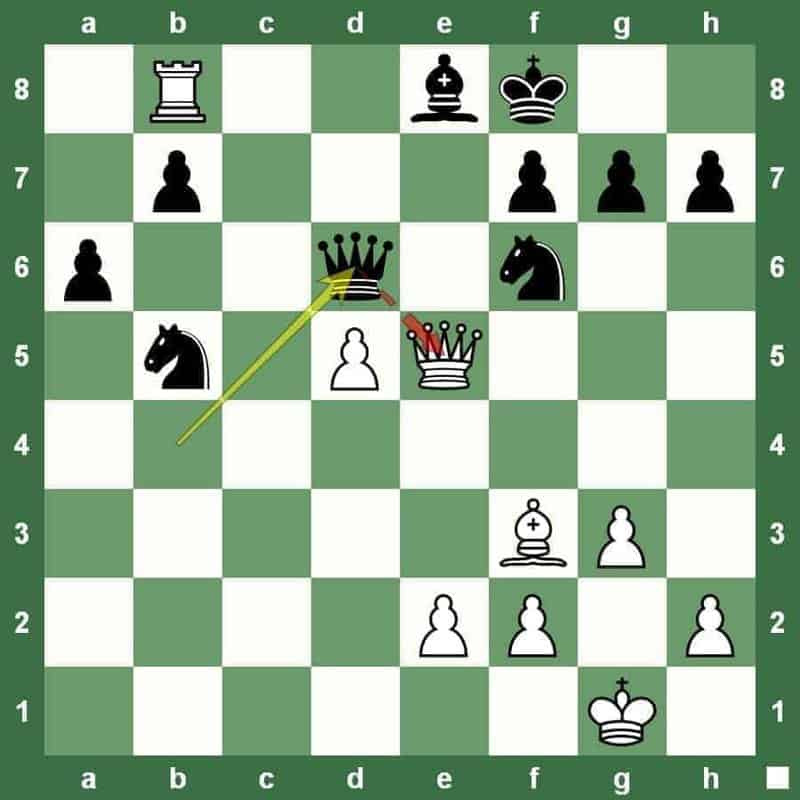
It was a great move since Black already saw that the White Rook would be trapped in a few moves.
Also Black has already made a plan to block the advancing pawns of White. This tactic of blocking opponents important square puts a lot of pressure to your opponent.
In this game, White has no choice but to resign. The lesson here is to avoid getting your chess pieces in a tight square where there is no chance of escape, identify possible squares that can be blocked.
Check out the chess middle game tactic and notation below:
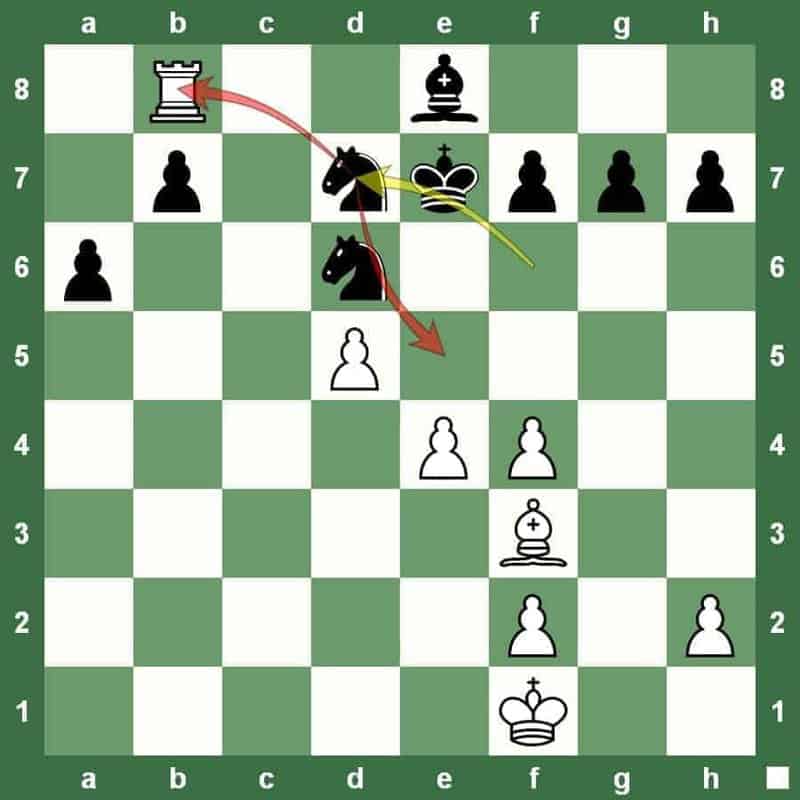
1. ♖fc1 ♖xc1+ 2. ♖xc1 ♘xb5 3. ♖c8+ ♗e8 4. ♕e5 ♔f8 5. ♗f3 ♕b4 6. ♖b8 ♕d6 7. ♕f4 ♕xf4 8. gxf4 ♘d6 9. ♔f1 ♔e7 10. e4 ♘d7 11. ♖a8 ♘b6 12. ♖b8 ♔d7 13. e5 ♔c7 14. ♖xe8 ♘xe8 15. d6+ ♔c8 16. ♗g4+ ♘d7 17. f5 ♘xe5
Chess Lessons, Tricks and Traps in the End Games
A serious chess player will never ignore learning valuable chess lessons in the end game…
You have successfully entered the end game, and you got the upper hand in the opening and the middle game, it is time to keep that momentum going in the end game.
I am not good in end games, and that is one of my weakness, I get to pass the opening games, go through some fierce exchanges in the middle game and then I get beaten in the end game.
There are some essential chess lessons, tricks, and traps I wanted to learn so bad, and I am sharing this with you.
Here are some of the Chess End Game lessons, tricks, and traps you should also know.
9. Learn To Draw With Your Rook (Black Wins)
If you have only had Rook and your opponent have a Rook and a Pawn during an end game that only means that your opponent is going to have a plan to promote that to a Queen any moment in the game…
If you don't know how to stop your opponent's pawn from Queening using your Rook, then you will surely lose the game. In this example, we have the Black King is defending the Queening square, which is the right move for Black; this can help prevent White from accomplishing its goal to promote the pawn.
And you will also notice that the Black Rook is on an essential rank in this example it is the 6th rank. The White King cannot move forward because the Black Rook is attacking the 6th rank. See chess image below.
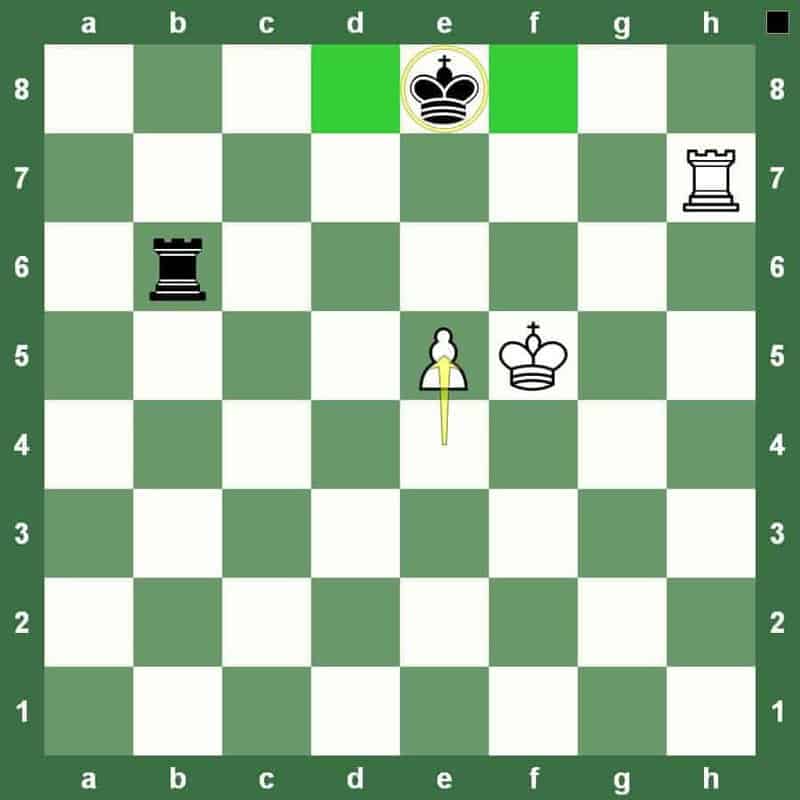
Now, Black was able to implement this tactic to the White by forcing a draw. The Black Rook was waiting for the White King to make a mistake, and Black capitalized on it.
Black Rook needs to check the White King continuously, and White cannot do any advancement or progress.The lesson here is to avoid getting a continuous check by using another minor chess piece as protection.
Check out the chess end game tactic and notation below:
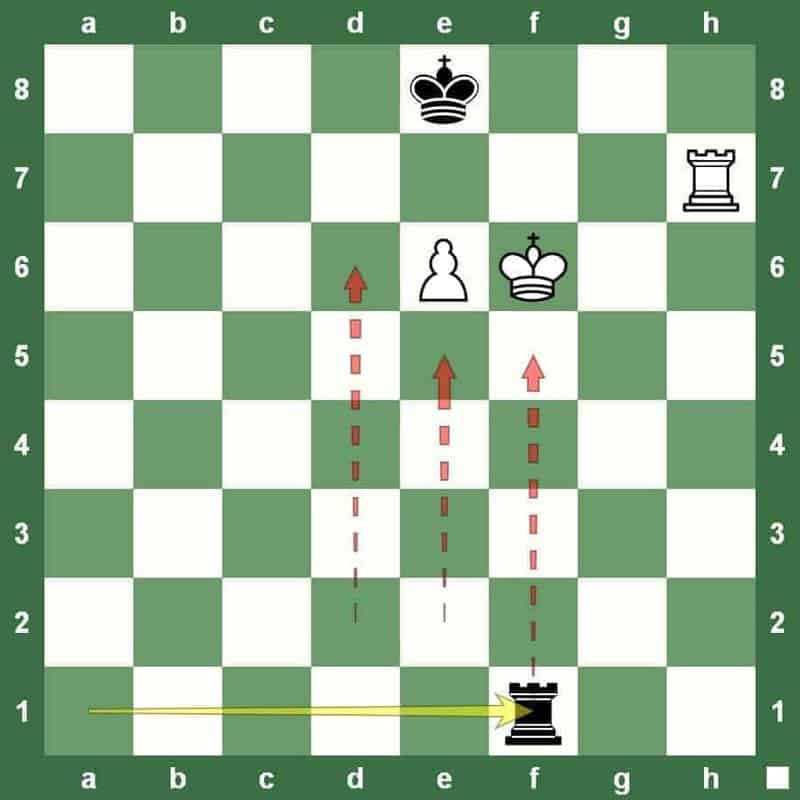
1. e5 ♖a6 2. e6 ♖a1 3. ♔f6 ♖f1+ 4. ♔e5 ♖e1+ 5. ♔d6 ♖d1+
10. Identify Which Side Can Win The Game (Black Wins)
During an end game, you will be dealing with individual decisions that can make you win or lose the game…
The decision to choose which side are you going to pursue and win and which side you can ignore during the game.
In this example, Black was able to identify which side can win the game, even if both are still having some minor chess pieces, Black decided to simplify the game and made some exchanges right away.
See the chess image below:
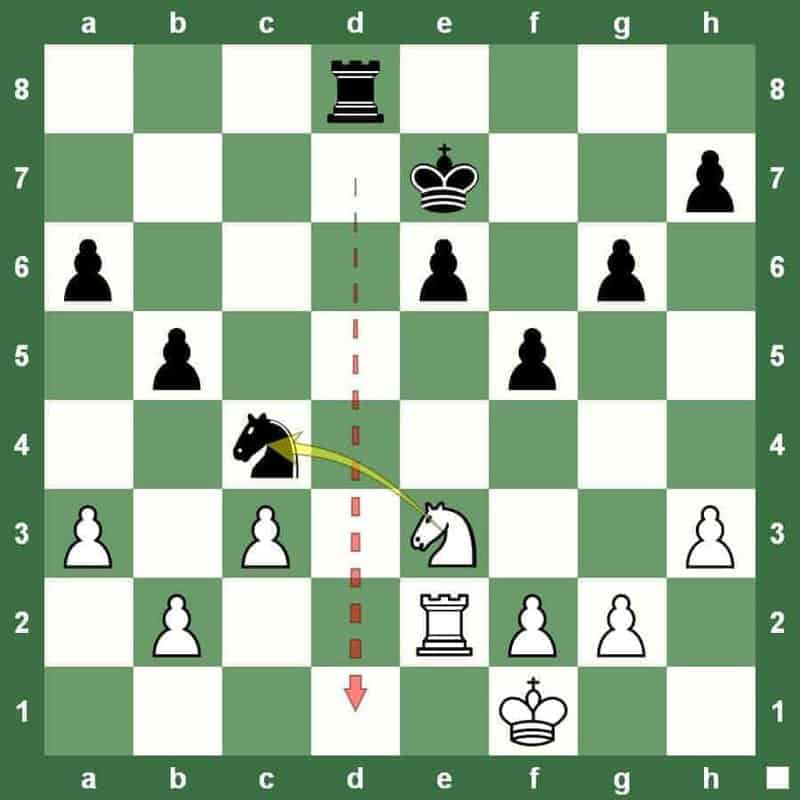
After the exchanges, then the real plan of Black has begun. Black noticed that the White's Queenside consisting of pawns, cannot make any progress. So, Black focused on the Kingside only and made sure that White will not be able to develop any passed pawn or any progress in that side.
The lesson here is to carefully identify which side can easily win and try to focus on that side and make sure that the other side cannot make any possible progressive move.
Check out the chess end game lesson and notation below:
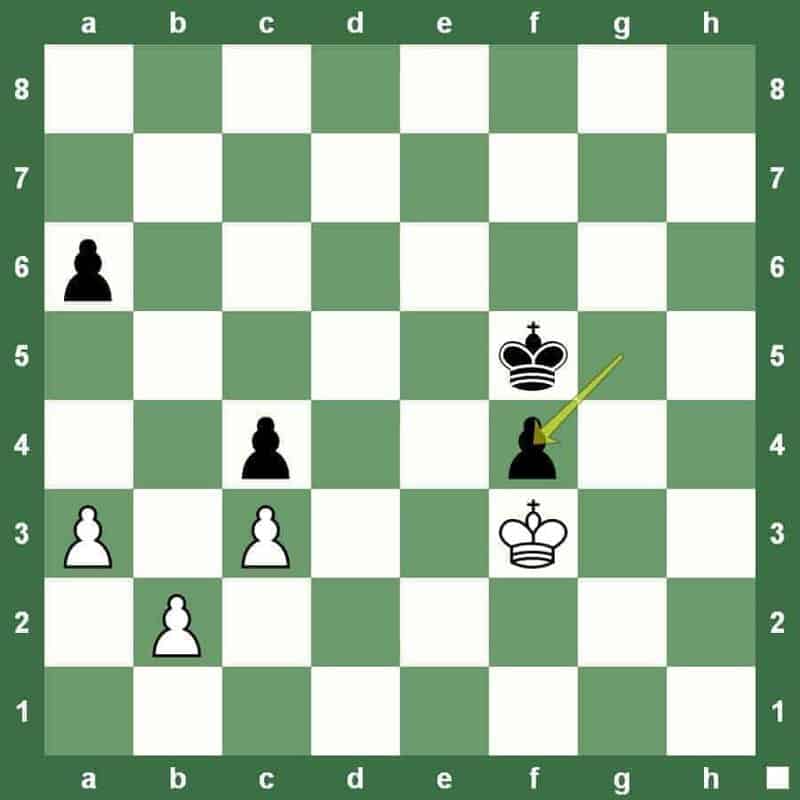
1. ♘xc4 ♖d1+ 2. ♖e1 ♖xe1+ 3. ♔xe1 bxc4 4. f4 e5 5. fxe5 ♔e6 6. ♔e2 ♔xe5 7. ♔e3 f4+ 8. ♔f3 ♔f5 9. h4 h6 10. g3 g5 11. hxg5 hxg5 12. gxf4 gxf4
11. Activate Your King During End Game (White Wins)
In chess end game you need to use all available chess pieces at your disposal… You need to know when or how you can activate your King in an end game.
I made a lot of mistake in not activating my King in end games, and my opponent was aware of that and used that to beat me in a chess game. If you have a Rook, you can stop your Opponent's King from getting into the action by preventing the King in a specific rank.
In this example, the Black King cannot give its Black Rook any help because the White Rook is attacking the 7th square. The Black King is useless at this point.
See the chess image below:

Now, the White King needs to take over the game even if it means that Black can capture one of its pawns.
While Black was able to capture the pawn, the White King was able to mobilize its passed pawn, and this is a big problem for Black.
Any attack by the Black Rook to the White will be rendered useless since the White's pawn will provide the potential to Queen.
The focus of Black will be on that pawn, and the advantage of that to the White is that it can start capturing Black's Pawns, and eventually White was able to capture all the Black pawns.
The lesson here is to to find a way to avoid the King from getting stuck on rank and not able to offer any help in the game. The King if activated in the end game, can be mighty.
Check out the chess end game lesson and notation below:
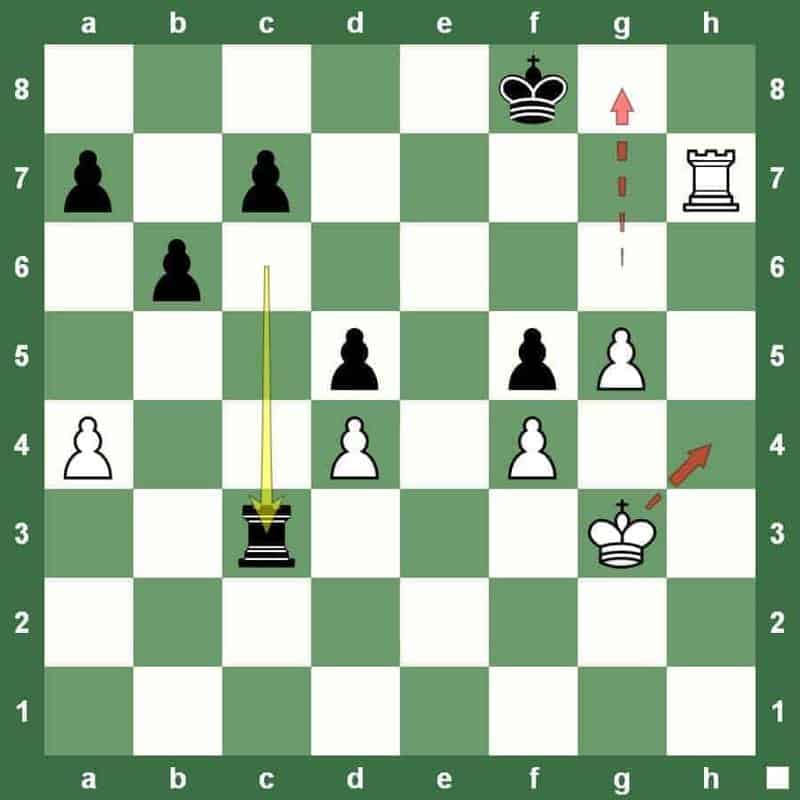
1. ♔g3 ♖xc3+ 2. ♔h4 ♖f3 3. g6 ♖xf4+ 4. ♔g5 ♖e4 5. ♔f6 ♔g8 6. ♖g7+ ♔h8 7. ♖xc7 ♖e8 8. ♔xf5 ♖e4 9. ♔f6 ♖f4+ 10. ♔e5 ♖g4 11. g7+ ♔g8 12. ♖xa7 ♖g1 13. ♔xd5 ♖c1 14. ♔d6 ♖c2 15. d5 ♖c1 16. ♖c7 ♖a1 17. ♔c6 ♖xa4 18. d6
12. Avoid Thinking The Game Is Already Over (White Wins)
Who would have thought that even if you have an advantage of 3 pawn pieces in an end game that you can lose it by checkmate…
The reason is some chess players assume a lot of things during the game. Well, I am guilty of that as well. If I know that I have a significant material advantage, I will be missing a lot of traps or tricks that can occur in the end game.
In this example, White has one pawn left while Black has four pawns and one Black pawn is already a passed pawn.
See chess image below.
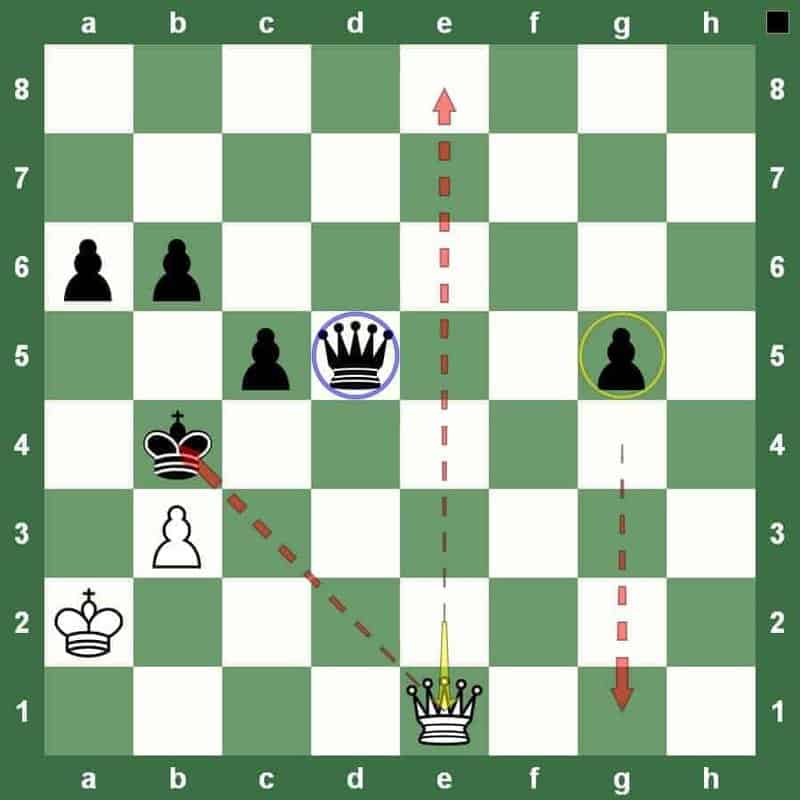
So, White was trying to force a draw with black I guess, based on what the White Queen is trying to do. Once it was White's turn, the checks were coming from a different side of the e file…
And Black was not aware of the trap that White was waiting for, it the King's move that set the trap and Black saw the trap and was not able to escape it and loses the game.
The lesson here is staying focus and do not assume that the game is already won by or the game is already a draw or else you will miss traps or tactics that can cause you the game.
Check out the chess end game lesson and notation below:

1… ♕d5 2. ♕e1+ ♔b5 3. ♕e8+ ♔b4 4. ♕e1+ ♔b5 5. ♕e8+ ♕c6 6. ♕e2+ c4 7. ♕e5+ ♔b4 8. ♕e7+ ♔a5 9. ♔a3
13. Master the King and Pawn End Game
This can end up in a disaster if you don't know how to win in a King and Pawn End Game… I was struggling before when I don't have a sound game plan in winning with a Pawn against a lone King.
So, in this example, the setup is simple; we have the two Kings of Black and White and one pawn for White.
See chess image below.

The idea is White should win this easily by promoting the Queen, but the problem is if you do not know some of the essential steps and rules of a King and Pawn end game. Rules to win a King and Pawn End game
- The first is to have one space between the Black King and White King.
- The second rule is that whoever controls the right square wins.
Ok, so when you are playing White, the King should have a forward advancing movement that will have only one space between the two Kings.

And in this example, if the Black King moves to the right or left, the White King should be occupying the opposite side and continue with forward advancing movement.
The second rule should be applied once you almost reach the last rank of the chess board, the White King, in this example, should have control of the right square or the Queening square.
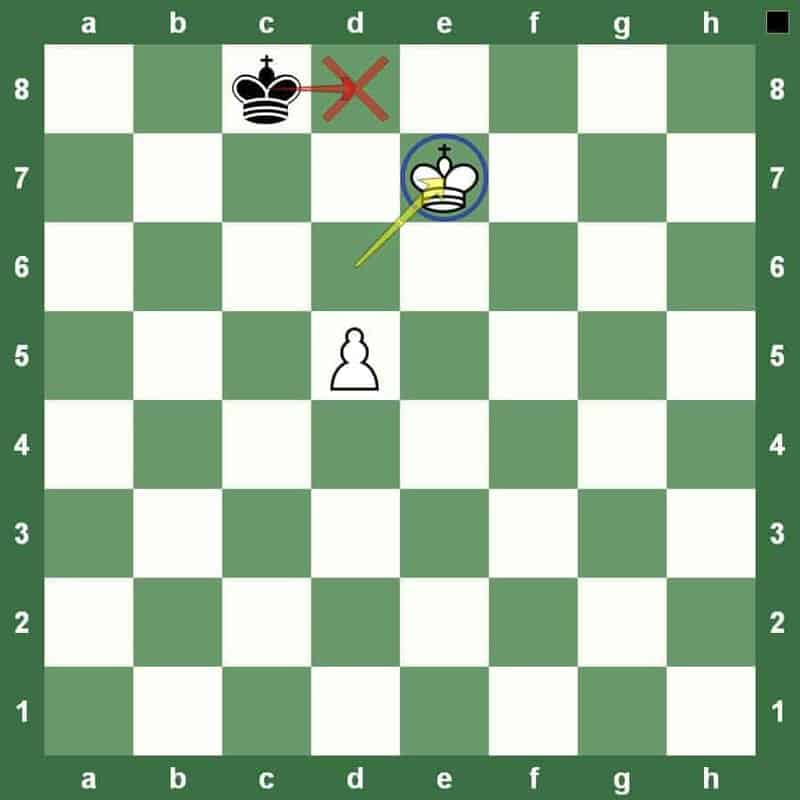
This is very important because if your opponent, the Black King, has control of the Queening square, then the game will be drawn.
The lesson here is to avoid having more than one space between your Kings, and always keep in mind that you need to be controlling the right square to promote your pawn successfully.
Check out the chess end game tactic and notation below:

1. ♔e4 ♔d6 2. ♔d4 ♔c6 3. ♔e5 ♔d7 4. ♔d5 ♔e7 5. ♔c6 ♔e6 6. d4 ♔e7 7. d5 ♔d8 8. ♔d6 ♔c8 9. ♔e7 ♔c7 10. d6+ ♔c8 11. d7+ ♔c7
Wrapping Up
This guide is quick and straightforward for learning some chess tricks but very useful if you are going to understand the concepts and principles behind the lessons.
An essential part of this article is that you can analyze the traps and lessons on a particular part of the chess game.
If you want to learn chess tricks on the opening game, you can go through four examples given, and you can pick up great ideas on the opening match.
The same goes thru the middle game and end game. Another beneficial thing about this is that you can analyze chess tricks and lessons for either the Black or White pieces.
I had fun researching and analyzing these chess lessons, tricks, and traps for you…
I do hope you were able to learn something new, if you do have some chess lessons or tricks you want to share with us, please do leave your comment below.
I hope you have fun learning these chess tricks! 🙂

